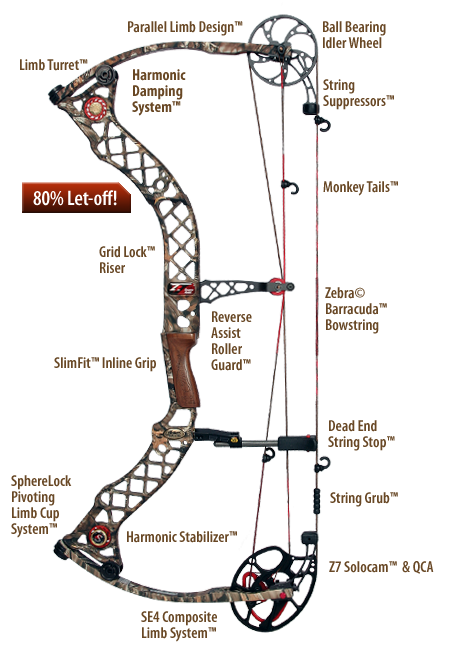 |
|
|
| The people of Crete practiced archery and Cretan mercenary archers were in great demand. Crete was known for its unbroken tradition of archery. The Greek god Apollo is the god of archery, also of plague and the sun, metaphorically perceived as shooting invisible arrows, Artemis the goddess of wild places and hunting. Odysseus and other mythological figures are often depicted with a bow.During the invasion of India, Alexander the Great personally took command of the shield-bearing guards, foot-companions, archers, Agrianians and horse-javelin-men and led them against the Kamboja clans—the Aspasios of Kunar valleys, the Guraeans of the Guraeus (Panjkora) valley, and the Assakenois of the Swat and Buner valleys. The early Romans had very few archers, if any. As their empire grew, they recruited auxiliary archers from other nations. Julius Caesar's armies in Gaul included Cretan archers, and Vercingetorix his enemy ordered "all the archers, of whom there was a very great number in Gaul, to be collected". By the 300s, archers with powerful composite bows were a regular part of Roman armies throughout the empire. After the fall of the western empire, the Romans came under severe pressure from the highly skilled mounted archers belonging to the Hun invaders, and later Eastern Roman armies relied heavily on mounted archery. During the Middle Ages, archery in warfare was not as prevalent and dominant in Western Europe as popular myth sometimes dictates. Archers were quite often the lowest-paid soldiers in an army or were conscripted from the peasantry. This was due to the cheap nature of the bow and arrow, as compared to the expense needed to equip a professional man-at-arms with good armour and a sword. Professional archers required a lifetime of training and expensive bows to be effective, and were thus generally rare in Europe (see English longbow). The bow was seldom used to decide battles and often viewed as a "lower class weapon" or as a toy, by the nobility. However, among the Vikings, even royalty such as Magnus Barelegs used archery effectively, and the Muslims used archery, presumably also in their numerous raiding expeditions all over the Western European seaboard, in the 9th and 10th centuries.By the time of the Hundred Years' War, the English had learned how to employ massed archery as an instrument of tactical dominance, with their English longbows. Tournaments were sponsored, with prizes for winners, among other ways of encouraging archery. There was therefore much motivation and incentive to become an expert with the longbow and the various English kings were able to recruit thousands of archers per year.The crossbow became quite popular during the Middle Ages. However, the renowned armour-piercing power of the crossbow caused fear amongst the well-armoured nobility and it was banned by the Second Council of the Lateran, although to little avail. |
|
|
|
|
| A longbow is a type of bow that is tall (roughly equal to the height
of the person who uses it); this will allow its user a fairly long draw,
at least to the jaw (the average length of the Mary Rose arrowshafts is
75 cm/30 in). A longbow is not significantly recurved. Its limbs are relatively
narrow so that they are circular or D-shaped in cross section. Flatbows
can be just as long; the difference is that, in cross-section, a flatbow
has limbs that are approximately rectangular.
Organizations which run archery competitions have set out formal definitions for the various classes; many definitions of the longbow would exclude some medieval examples, materials, and techniques of use. According to the British Longbow Society, the English longbow is made so that its thickness is at least ? (62.5%) of its width, as in Victorian longbows, and is widest at the handle. This differs from the Medieval longbow, which had a thickness between 33% and 75% of the width. Also, the Victorian longbow does not bend throughout the entire length, as does the medieval longbow. Longbows have been used for hunting and warfare, by many cultures around the world, a famous example being the English longbow, during the Middle Ages. |
 |
|
|
|
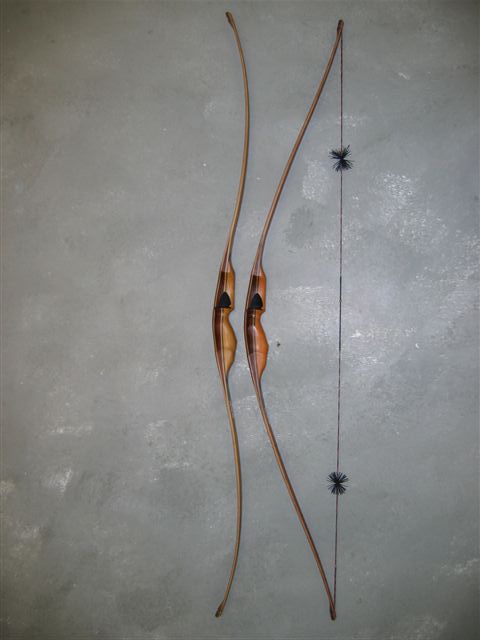 |
Because the longbow can be made from a single piece of wood, it can
be crafted relatively easily and quickly. Amateur bowyers today can craft
a longbow in about ten to twenty hours, while highly skilled bowyers, such
as those who produced medieval English longbows, can craft wooden longbows
in just a few hours.
One of the simpler longbow designs is known as the self bow. By definition, a self bow is made from a single piece of wood. Truly traditional English longbows are self bows, made from yew wood. The bowstave is cut from the radius of the tree so that the sapwood (on the outside of the tree) becomes the back two thirds and the belly, the remaining one third, is heartwood. Yew sapwood is good only in tension, while the heartwood is good in compression. However, one must make compromises when making a yew longbow, as it is difficult to find perfect unblemished yew. The demand for yew bowstaves was such that by the late 1500s, mature yew trees were almost extinct in northern Europe. In other desirable woods such as Osage orange and Mulberry the sapwood is almost useless and is normally removed entirely. Longbows, because of their narrow limbs and rounded cross-section (which does not spread out stress within the wood as evenly as a flatbow’s rectangular cross section), need to be either less powerful, longer or of more elastic wood than an equivalent flatbow. In Europe the latter approach was used, with yew being the wood of choice, because of its high compressive strength, light weight and elasticity. Yew is the only widespread European timber that will make good self longbows, and has been the main wood used in European bows since Neolithic times. |
|
|
|
| More common and cheaper hard woods, like elm, oak, ash, hazel or maple
are good for flatbows. A narrow longbow with high draw-weight can be made
from these woods, but it is likely to take a permanent bend (known as "set"
or "following the string") and would likely be outshot by an equivalent
made of yew.
Wooden laminated longbows can be made by gluing together two or more different pieces of wood. Usually this is done to take advantage of the inherent properties of different woods: some woods can better withstand compression while others are better at withstanding tension. Examples include hickory and lemonwood or bamboo and yew longbows: hickory or bamboo is used on the back of the bow (the part facing away from the archer when shooting) and so is in tension, while the belly (the part facing the archer when shooting) is made of lemonwood or yew and undergoes compression (see bending for a further explanation of stresses in a bending beam). Traditionally made Japanese yumi are also laminated long bows, made from strips of wood: the core of the bow is bamboo, the back and belly are bamboo or hardwood and hardwood strips are laminated to the bows sides to prevent twisting. Today, good laminated longbows may be made of wood or can be purchased commercially. Any wooden bow must have gentle treatment and be protected from excessive damp or dryness. Wooden bows may shoot as well as fiberglass, but they are more easily dented or broken by abuse. Bows made of modern materials can be left strung for longer amounts of time than wood bows. Wooden bows should be unstrung immediately after use to avoid large amounts of set. |
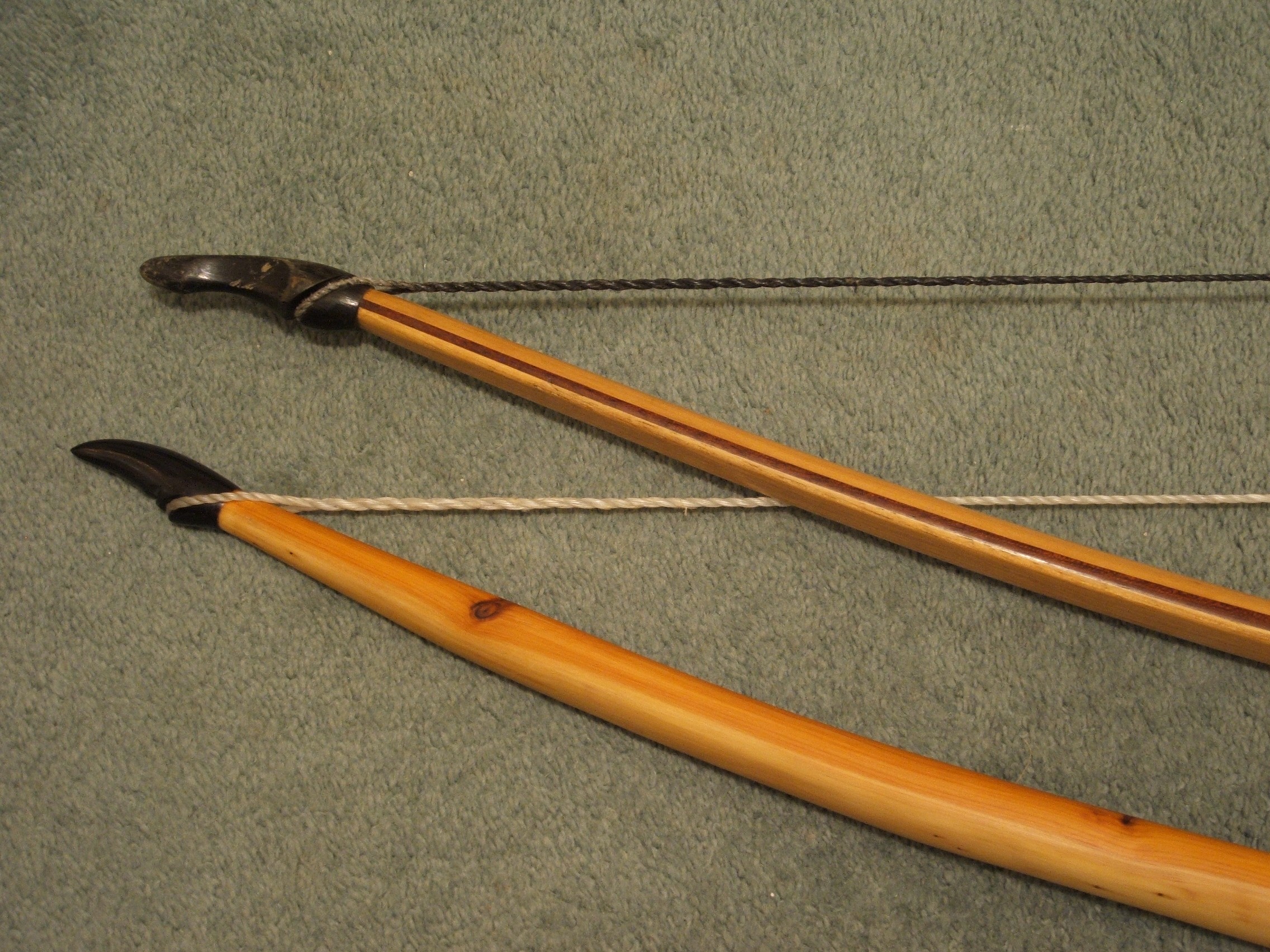 |
|
|
|
| Back to Top |
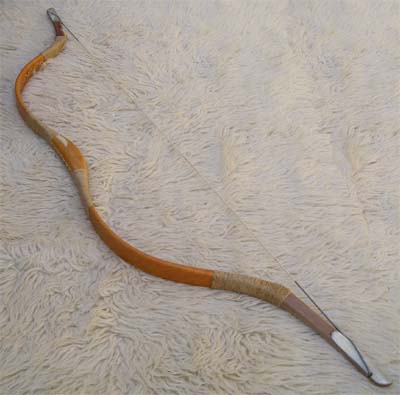 |
In a crossbow, the limbs of the bow are attached to a crosspiece or
stock in order to allow for mechanical pulling and holding of the string.
This allows for a much larger draw weight than could be drawn and held
by hand. A crossbow can be much smaller than a manually-held bow of the
same power, or may be constructed on a much larger scale like the arbalest
and ballista for use as a siege engine.
The drawing of the bow could be accomplished through use of a lever, the archer's legs, or complex windlass designs. The principal disadvantage to a crossbow is the time taken for reloading. While repeating crossbows existed, as did crossbows which shot more than one arrow at a time, for the most part an archer could deliver many times more arrows per minute than a crossbowman could. The weapon's additional weight and the greater potential for mechanical failure could also be a problem for armed forces on the move. |
|
|
|
| Back to Top |
| The central riser of a compound bow is usually made of aluminium or magnesium. Many risers are made of the aircraft-grade 6061 aluminium alloy. Risers are designed to be as rigid as possible. The riser is the central mount for other components such as the limbs, sights, stabilizers and quivers. Limbs are made of composite materials and are capable of taking high tensile and compressive forces. The limbs store all the energy of the bow — no energy is stored in the pulleys and cables. In the most common configuration, there is a cam or wheel at the end of each limb. The shape of the cam may vary somewhat between different bow designs. There are several different concepts of utilizing the cams to store energy in the limbs, and these all fall under a category called bow eccentrics. The four most common types of bow eccentrics are Single Cam, Hybrid Cam, Dual Cam and Binary Cam. However, there are also other less common designs, like the Quad Cam and Hinged. Compound bow strings and cables are normally made of high-modulus polyethylene and are designed to have great tensile strength and minimal stretchability, in order that the bow transfers its energy to the arrow as efficiently and durably as possible. In earlier models of compound bows, the cables were often made of plastic-coated steel. |
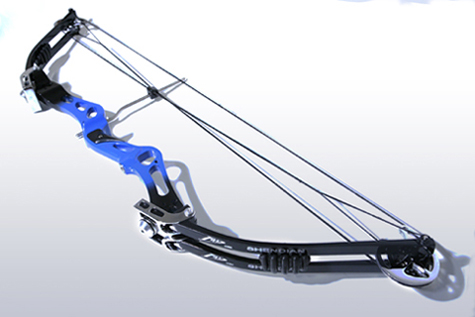 |
|
|
|
 |
A compound bow is a modern bow that uses a levering system, usually
of cables and pulleys, to bend the limbs.
The limbs of a compound bow are usually much stiffer than those of a recurve bow or longbow. This limb stiffness makes the compound bow more energy efficient than other bows, but the limbs are too stiff to be drawn comfortably with a string attached directly to them. The compound bow has the string attached to the pulleys (cams), one or both of which has one or more cables attached to the opposite limb. When the string is drawn back, the string causes the pulleys to turn. This causes the pulleys to pull the cables, which in turn causes the limbs to bend and thus store energy. The use of this levering system gives the compound bow a characteristic draw-force curve which rises to a peak weight and then "lets off" to a lower holding weight. The compound bow is little affected by changes of temperature and humidity and gives superior accuracy, velocity, and distance in comparison to other bows. The compound bow was first developed in 1966 by Holless Wilbur Allen in Missouri, and a US patent was granted in 1969. The compound bow has become increasingly popular. In the United States, the compound is the dominant form of bow. In literature of the early 20th century, composite bows have been described as "compound". |
|
|
|
| Back to Top |